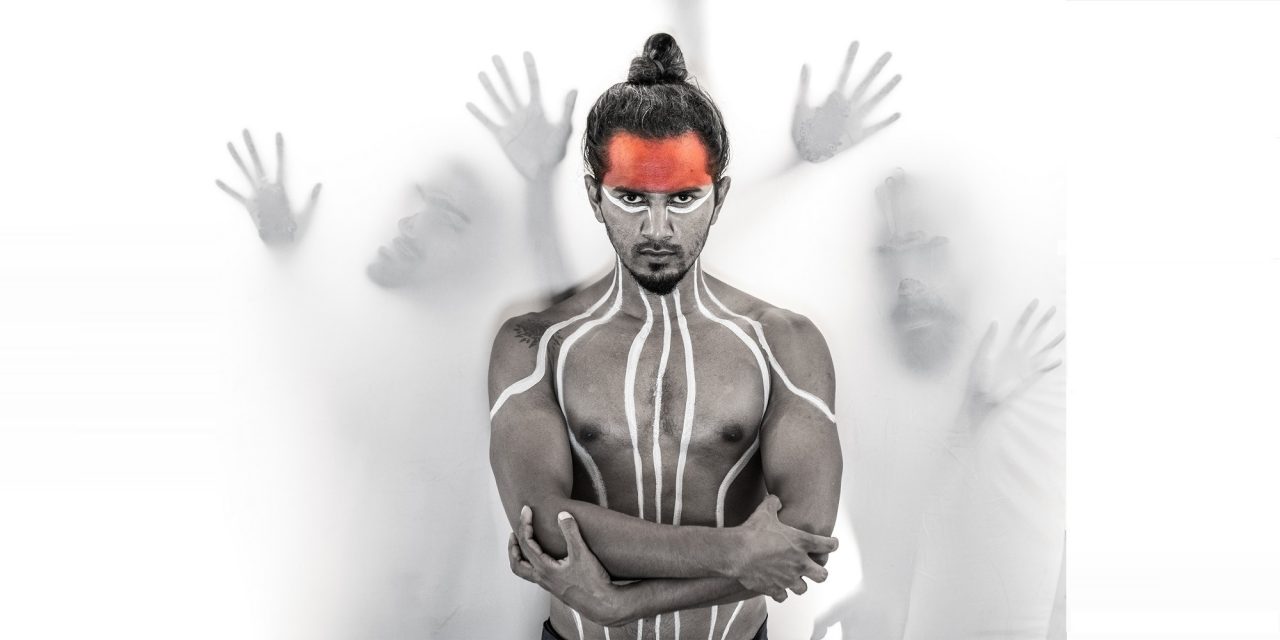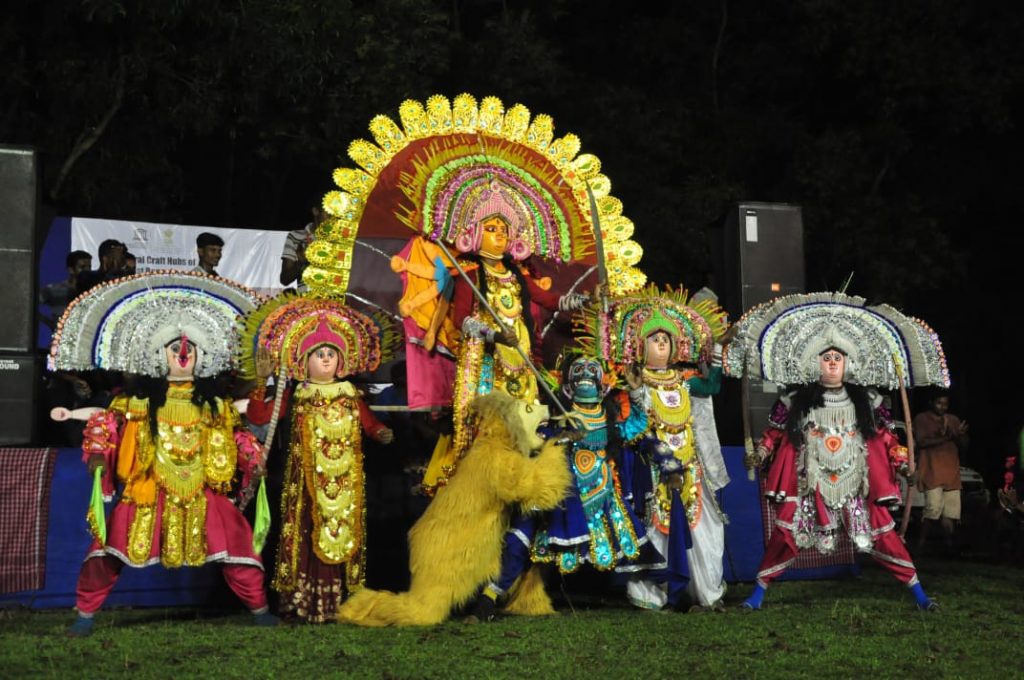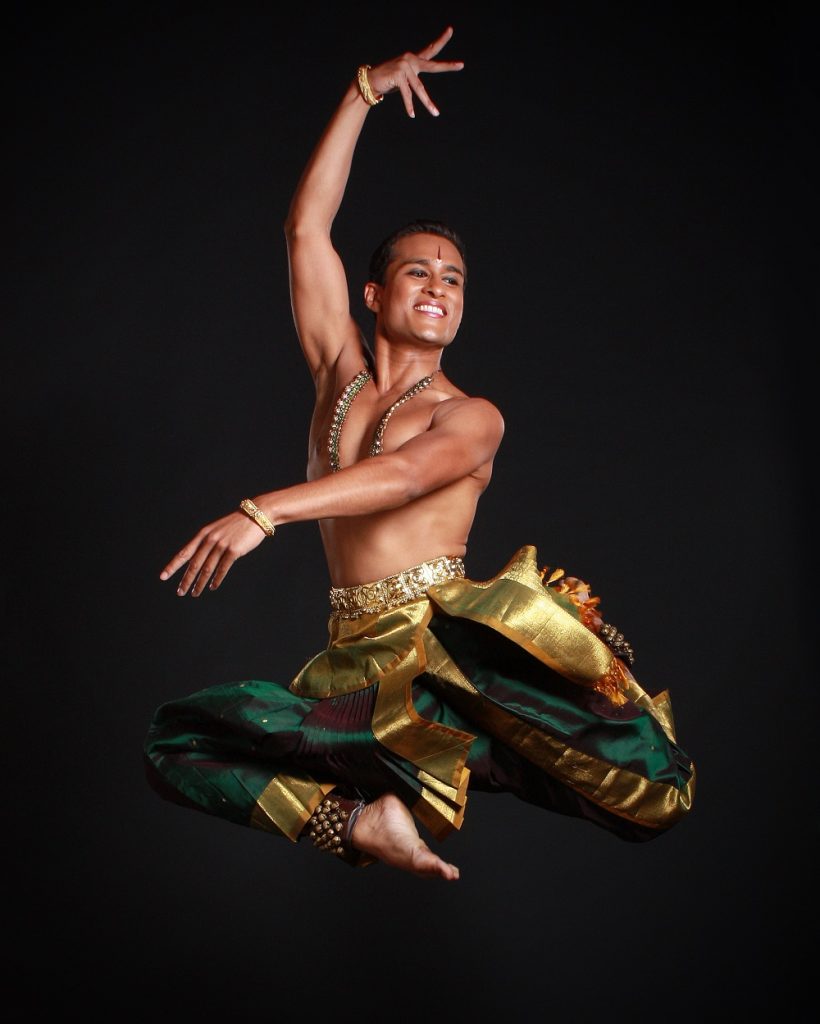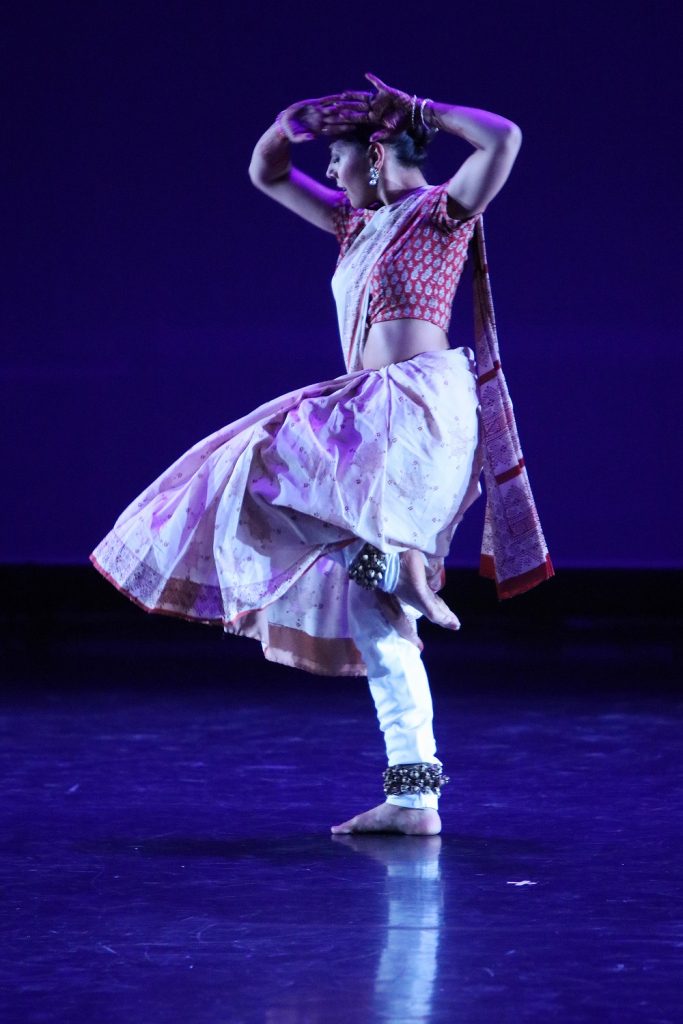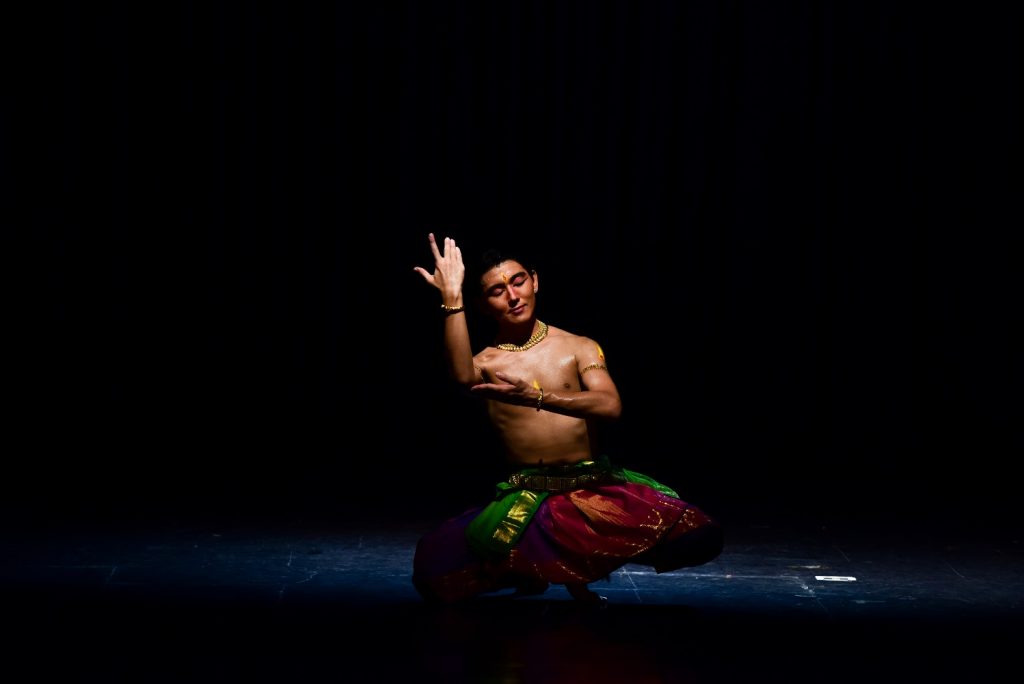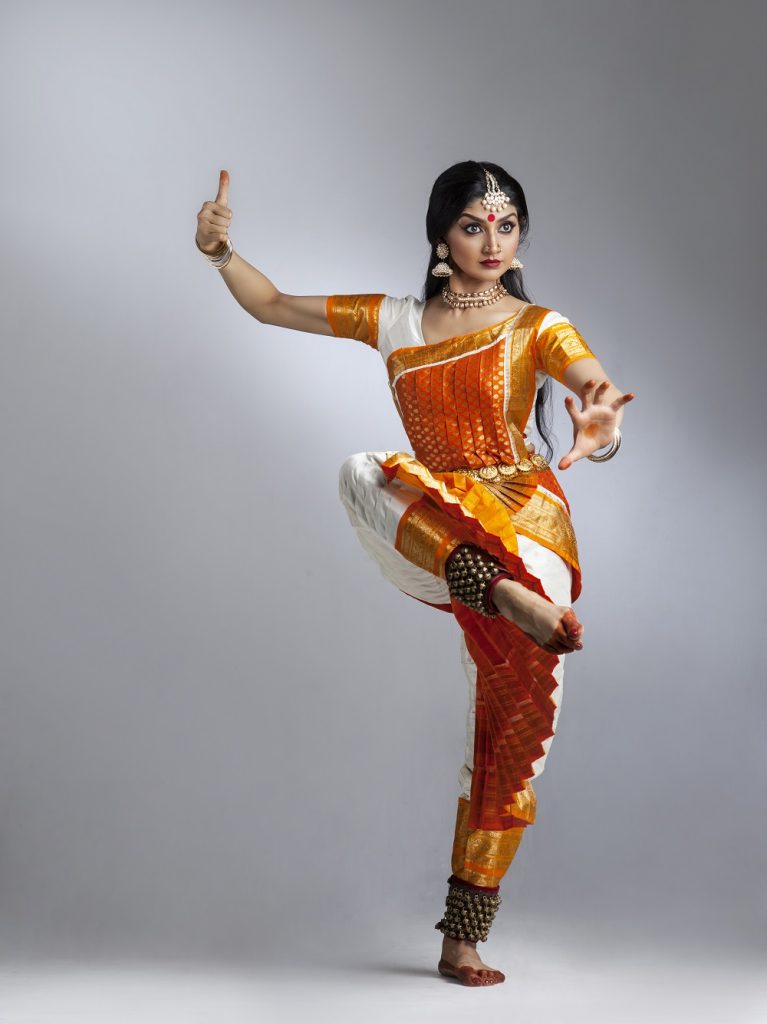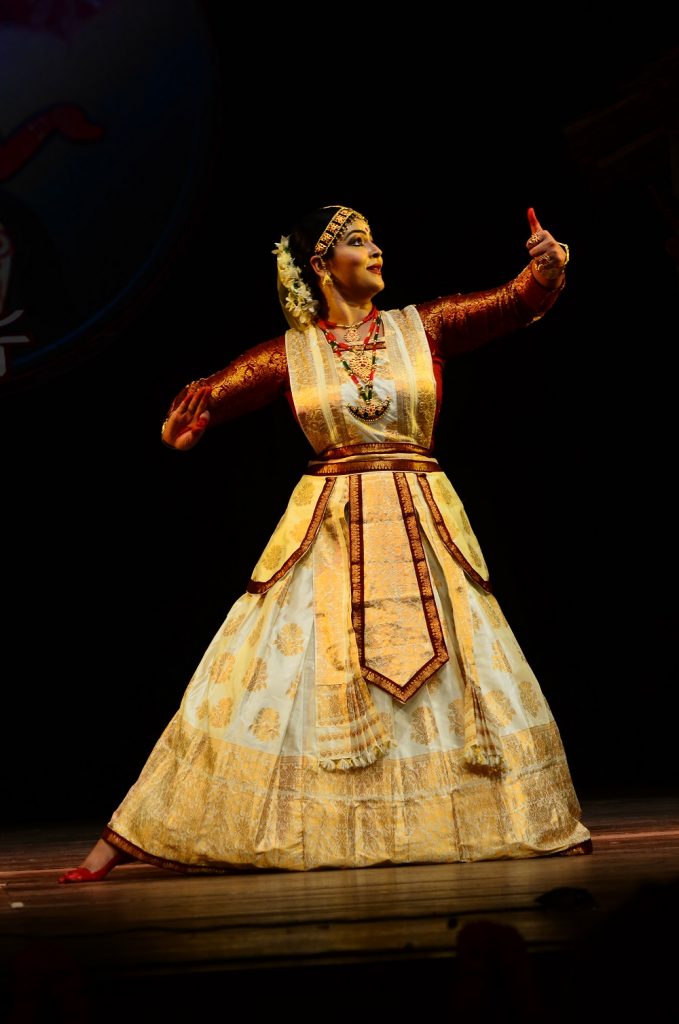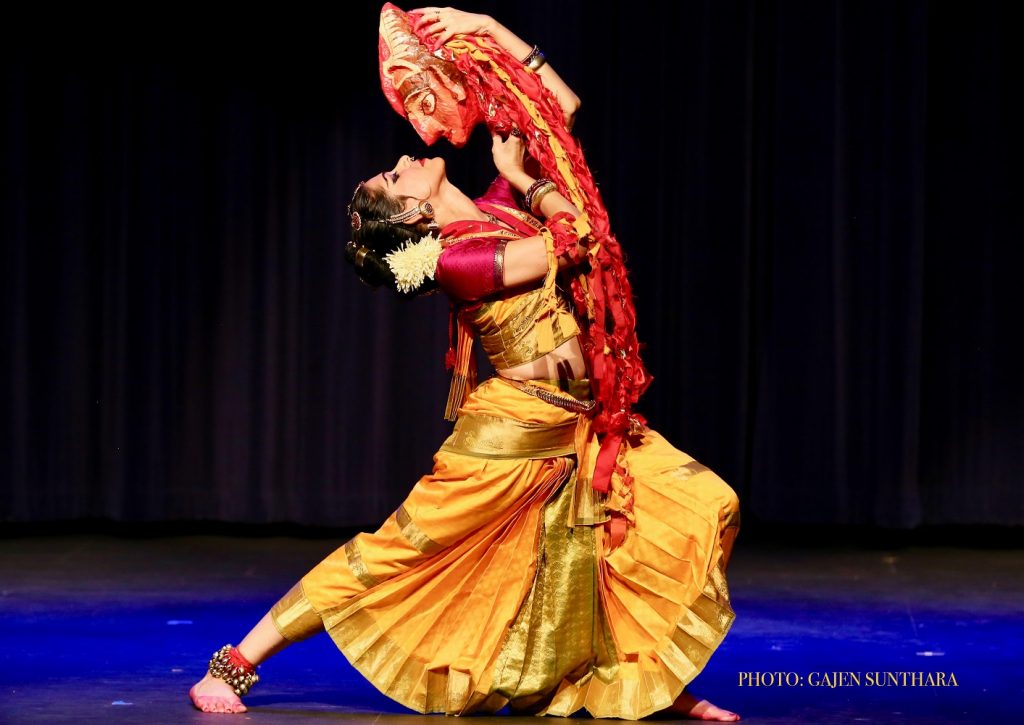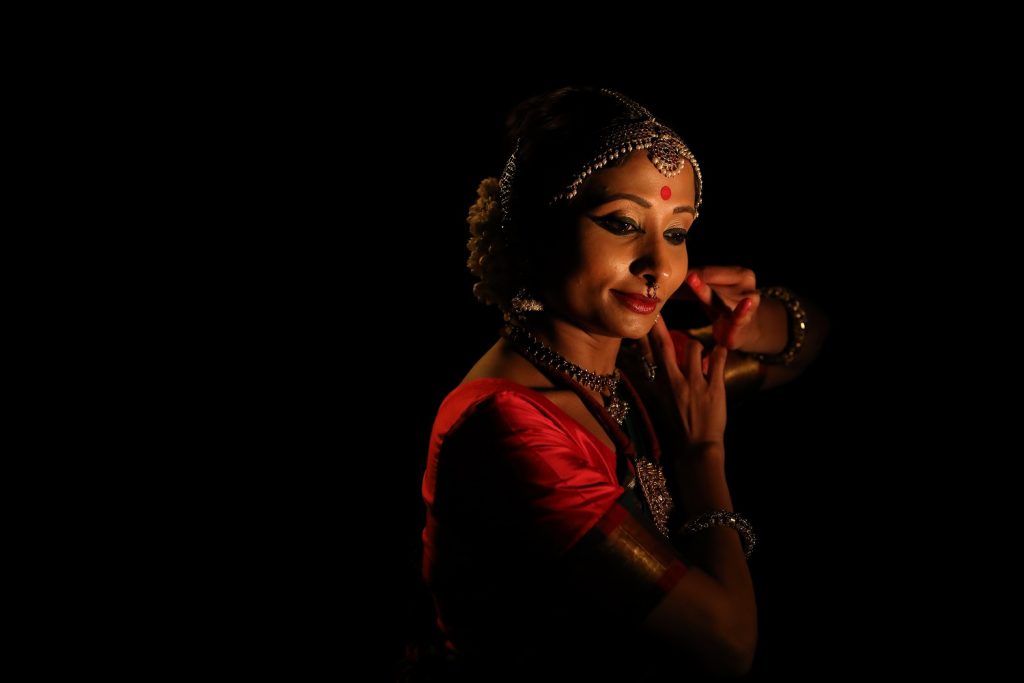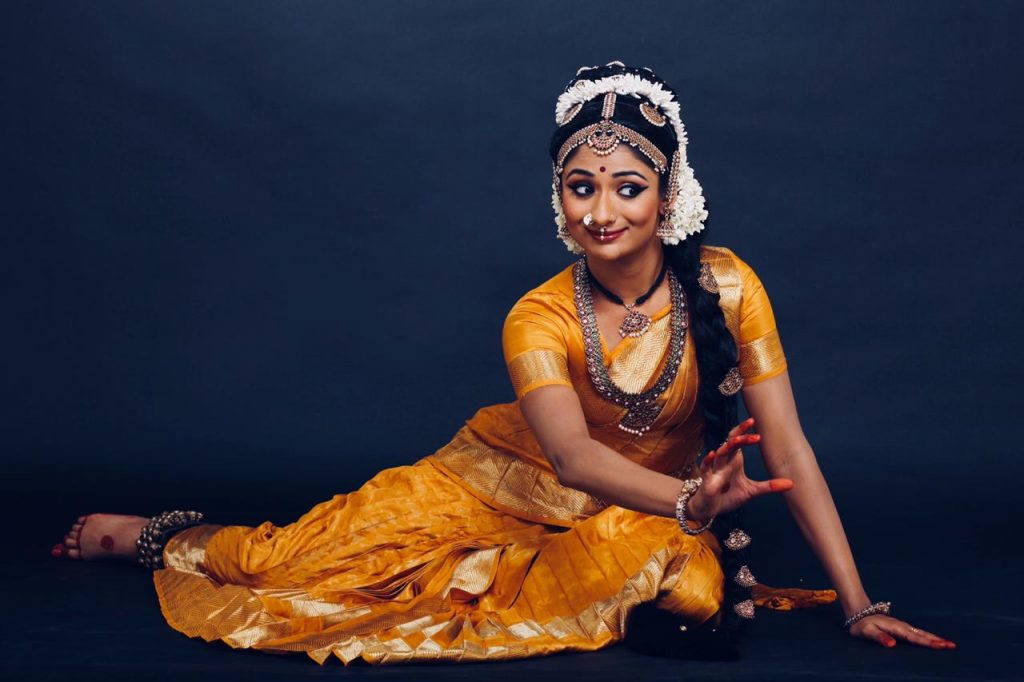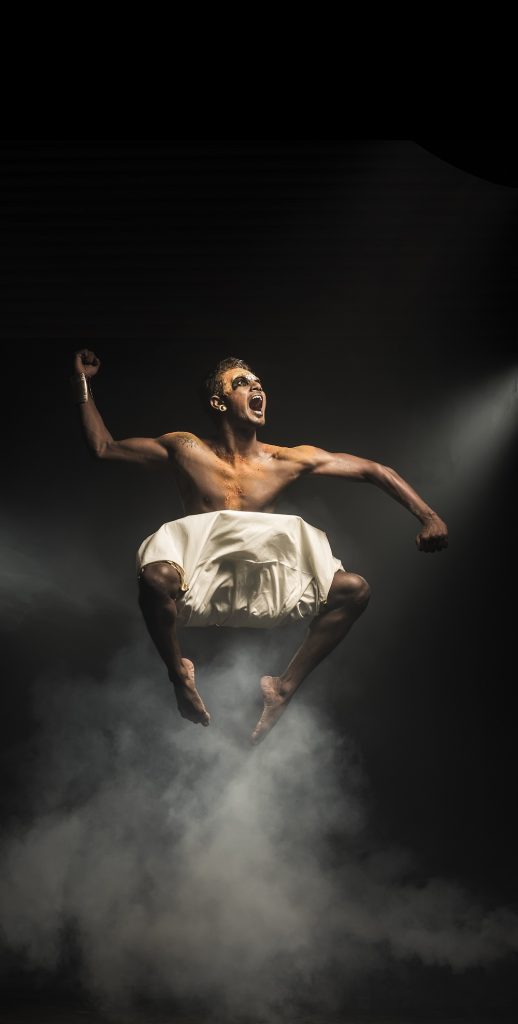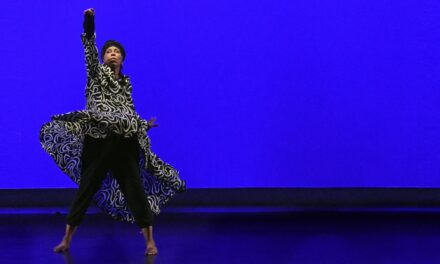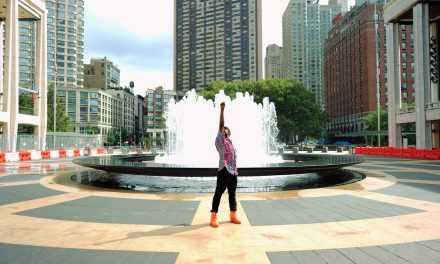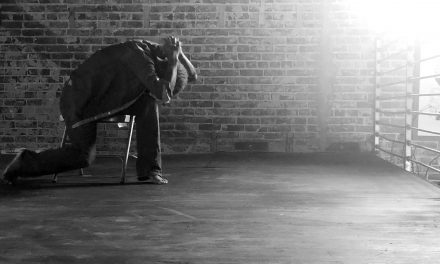On September 20-27, 2020, the Indo-American Arts Council (IAAC) will present a Virtual Erasing Borders Dance Festival at 8:30pm EST (5:30pm PST) on Facebook Live. Now in its twelfth year of the festival, IAAC has expanded the event to include the bringing together of eleven artists trained in Indian dance forms from across the world.
In the September 3, 2020 press release Deepsikha Chatterjee, Festival Director stated, “Moving to a virtual format has its own artistic challenges, but we believe it opened up many possibilities. Our artists are from across the world, representing many of India’s dance forms. Bringing them together on an online platform was not only the most responsible and exciting way of showcasing their work but also displaying the virtuosity of diversity.”
The Erasing Borders Dance Festival of the Indo-American Arts Council (IAAC) invites dancers, dance companies and choreographers across the world to present works of artistic excellence sharing movement, heritage and inspiration from the Indian subcontinent. The festival is curated for the New York City public and can now be viewed globally in its virtual edition.
The IAAC supports all the artistic disciplines in classical, fusion, folk and innovative forms influenced by the arts of India. We work cooperatively with colleagues around the United States to broaden our collective audiences and to create a network for shared information, resources and funding. Our focus is to help artists and art organizations in North America as well as to facilitate artists from India to exhibit, perform and produce their work here. The IAAC is a 501(c)(3) tax-exempt organization. All donations are tax-deductible to the fullest extent allowable by law.
Here is the Virtual Erasing Borders Dance Festival Schedule:
Sunday, September 20, 2020
Shambhu Nath Karmakar/Ashpara Care Club (Purulia Chhau)
Shambhu Nath Karmakar (Ashpara Care Club/Purulia Chhau) is a Purulia Chhau artist trained in the region’s traditional martial and acrobatic dance form under guru Dhananjay Mahato. He has received national scholarships in dance from Ministry of Culture, New Delhi. He is involved in Purulia Chhau performance, training, workshops, exhibitions, and competitions. He and his group Ashpara Seva Jatna Chhau Training Center has been invited to various national and international festivals including Japan, Srilanka, Bangladesh and others. He has established Seva Jatna Chhau Institution to teach the youth this martial dance form and to deepen their connections to their cultural roots.
Monday, September 21, 2020
Neha Mondal Chakravarty (Kalakshetra Bharatanatyam)
Krishnakshi Kashyap (Sattriya)
Neha Mondal Chakravarty (Kalakshetra Bharatanatyam) hailing from India, New Delhi, is a Bharatanatyam performer, teacher and choreographer, who currently resides in Singapore. An alumna of Kalakshetra Foundation, Chennai, Neha was trained by stalwarts like Shri A. Janardhanan, Sheejith Krishna, Smt. Jyotsana Menon and Ms. Leela Samson. Her experience with Kalakshetra’s repertory company, under the guidance of Leela Samson transformed her into a subtle and thinking dancer. Neha worked as an empaneled “A” grade artist with the Ministry Of Information and Broadcasting, New Delhi.
Krishnakshi Kashyap (Sattriya) is a Sattriya dancer, educator, choreographer, cultural and social ideapreneur. Sattriya dance is 500 year old living tradition practiced in Sattras-monsatic communities of Assam. A recipient of the Young Talent Artiste Award by NEZCC, Ministry of Culture, Govt of India, she was conferred the Dalmia Cement Young Achiever’s Award 2020 for her exceptional achievements in the field of art and culture. As a practitioner-performer, she promotes Sattriya Dance, the 600 years old living tradition of Assam, a state in North East India. Trained under renowned Gurus Shri Ramkrishna Talukdar, Shri Jatin Goswami and Smt.
Tuesday, September 22, 2020
Ganesh Vasudeva (Bharatanatyam)
Ganesh Vasudeva (Bharatanatyam) has been training in Bharatanatyam for more than 30 years. In the past few years Ganesh has choreographed and presented his own work to critical acclaim. More information can be found for Ganesh at www.ganeshvasudeva.com/.
Wednesday, September 23, 2020
Divyaa Unni (Bharatanatyam)
Arun Mathai (Bharatanatyam)
Divyaa Unni (Bharatanatyam) is an internationally recognized dancer, teacher and choreographer. She started learning dance at the tender age of three from highly respected and diverse dance gurus Kalamadalam Gopinath and RLV Anil Kumar. She was crowned “Kalathilakam” in the annual state-wide youth festival conducted by the Government of Kerala in the year 1990 and 1992.
Arun Mathai (Bharatanatyam) was first exposed to Bharatanatyam while watching his older sister in class, and would often imitate the moves he witnessed, using the coffee table as his stage. Encouraged by his parents he started studying at Kala Vandana Dance Center, in San Jose, California, under the rigorous but loving guidance of his guru, Smt. Sundara Swaminathan.
Thursday, September 24, 2020
Sandhya Raju (Kuchipudi)
Sandhya Raju (Kuchipudi) is a Kuchipudi dancer from Hyderabad. She has learnt the dance form from the legendary dance maestro Padma Bushan Dr. Vempati Chinna Satyam and his senior disciple Shri Kishore Mosalikanti Garu. She presented Kuchipudi as part of her Guru’s troupe as well as a solo artist. She is the founder director if Nishrinkala Dance Academy in Hyderabad. Beyond Kuchipudi dance, she has also explored other mediums of artistic expression through her acting in three short films. Her most notable one is “Natyam” on YouTube. She has acted in a Malayalam Feature Film and is currently filming for a dance based feature film where she plays the lead character of an Indian Classical Dancer.
Friday, September 25, 2020
Damir Tasmagambetov (Kalakshetra Bharatanatyam)
Barkha Patel (Contemporary Kathak)
Damir Tasmagambetov (Kalakshetra Bharatanatyam) is from the city of Almaty, Kazakhstan, in the heart of Central Asia. Damir holds a Bachelor and M.A degree from two Universities of Dance-one for each discipline in their respective country of origins. He completed his studies at the Kalakshetra Foundation, India with a 1st class Diploma in Bharatanatyam. He continued to expand his knowledge in Indian Classical Dance, graduating from The University of Madras to complete his master’s degree in Bharatanatyam in 2017. He has been selected by Indian Council for Cultural Relations (ICCR) as an Empaneled artist. By special invitation Damir was selected to become a Member of the International Dance Council (CID) under UNESCO in Paris, France.
Barkha Patel (Contemporary Kathak Company) is a touring artist who has performed at dance festivals in India to Jacob’s Pillow Inside/Out series in the U.S. She completed a choreographic fellowship with Jersey Moves/New Jersey Performing Arts Center. Currently, Barkha is working on her first, full evening ensemble work called Mukta, A Woman Liberated. Recently, Barkha received a 2020 Fellowship from the New Jersey State Council on the Arts and is a mentee of Dance/USA Institute for Leadership. Barkha teaches kathak to young and adult students in NYC/NJ and now across the world via Zoom. Barkha co-founded a Kathak meetup group, an inclusive space for Kathak dancers to practice and discuss crucial topics to the art form.
Saturday, September 26, 2020
Mesma Belsaré (Shilpa Natana)
Mesma Belsaré (Shilpa Natana) is a dancer, painter and actor, described by The New York Times as “a tour de force…a true act of transcendence…”, “as mesmerizing as staring into the heart of a fire”, by The Dance Current Magazine, and with a “capacity for intense involvement” by The Hindu. Belsaré studied Bharatanātyam in India under Sri Shankar Hombal at the Kalāpadma Academy, under Padmashri Geeta Chandran at the Nātya Vriksha Academy of Performing Arts and continues learning with New York based Maya Kulkarni and creating new dance works inspired by classical visual arts/architecture, Sanskrit literature and Greek mythology/philosophy.
Sunday, September 27, 2020
Vishwakiran Nambi (Contemporary)
Workshops by Nahid Siddiqui (Sufi Kathak)
Vishwakiran Nambi (Contemporary) is a performer, choreographer, dance filmmaker, academic and Director of LOKA Studio for Movement Practices and the driving force behind Vishwakiran Nambi Dance Education (VNDE). He was the principal dancer, head of training and one of the principal choreographers of ‘Nritarutya Dance Company’ for over 10 years. His training is diverse ranging from Indian classical forms to Indian folk and martial dance forms. Though his foundation is in contemporary dance and Bharatanatyam, he constantly trains and explores the folk dimensions of South Indian dance and trains extensively in martial forms.
Nahid Siddiqui (Sufi Kathak) is a Kathak artist trained by Pandit Birju Maharaj and Baba Maharaj drawing from the aesthetics of Punjab and Lahore. During a phase of cultural turmoil, she was exiled in the UK, where she taught and lectured at institutions including the University of Surrey, Bharatiya Vidya Bhavan, and others. She has choreographed many works and created a Gharana/style combining Kathak aesthetics and Sufi spirituality.
About the Performances
Mahisasur Mardini, performed by Shambhu Nath Karmakar
A traditional piece in the Purulia Chhau repertoire, this ensemble number introduces the all-powerful Goddess Durga (demon Mahisasur slayer) and her family as she vanquishes the evil buffalo demon. Each of the members of the family, Gods Ganesha, Kartik with his peacock companion, the great god Shiva, Goddesses Laksmi, Saraswati, and Durga and her lion companion enter the playing space, supported by the percussion of the Dhamsa drum, dhol drum, and the shehnai pipe. They show off their acrobatic process through leaps, jumps, and somersaults. Then comes the buffalo demon with his retinue of minor demons causing much destruction. Goddess Durga activates her omnipotent energy to tackle the demon. After a display of their strengths, good prevails over evil and the buffalo demon and his aides succumb to divine power. The Godly family can now assemble and shower their blessings on the earthly devotees. This piece is popular in the Bengali Durga puja circuit in the months of September and October.
Sukriti, performed by Neha Mondal Chakravarty
A woman who is born, like a seed within the depths of earth that has millions of possibilities waiting to start spreading its roots across the earth and reaching towards the sky. But not yet, as it awaits the perfect conditions like moisture which is karuna/compassion to nurture those possibilities. And then she rises like a million suns, protecting the world and its beings. A mother knows no bound, allowing the compassion to flow as her natural instinct. She also weeps silently when the human suffers! And when the equilibrium is disturbed in a world that lacks compassion/empathy/love we learn to evolve or co-exist. The presentation shall revolve around Love/compassion/Empathy, an attempt to look through and find references from the present and mythology, from sufi wanderers with their mysticism and philosophy on life, to Krishna, the charmer and forever longing for his love “Radha.” The ultimate source of life “Devi”, all pervading, and an epitome of compassion. Join her as she attempts to highlight and bring back these virtues, which are gradually being forgotten.
Rama Niranjana, performed by Krishnakshi Kashyap
The abhinaya-mimetic piece ‘Rama Niranjana’ is based on ‘Gunamala’, a scripture written by the great saint, poet, scholar and social, cultural and religious reformer Mahapurush Srimanta Sankardev in one night at the request of Koch king Nara Narayan in 1552. It is an abridged version of the ten cantos of the ‘Bhagawat Purana’- one of Hinduism’s eighteen great Puranas, where the poet recounts incidents from Lord Krishna’s life. It will depict mythological stories-the lifting of Govardhana mountain, overthrowing Kaliya snake and the ten incarnations of Lord Vishnu. This will be followed by two traditional dance types of Sattriya, the Ojapali and the Bhortal-cymbal dance. The music for this dance is specially recorded for performance using traditional musical instruments like the Khol, Flute, Cymbals and Violin.
Rojaghoria Saali, performed by Krishnakshi Kashyap
This is a pure dance number in ‘Lashya’-feminine style of Sattriya Dance. In Shankardeva’s era and later, Ahom kings patronized the Sattriya culture. The dancers were initially reluctant to perform the traditional dance outside the monasteries but accepted the royal command. They reformed and revised a version of the traditional form for the King’s court, thus preserving the original form for the monasteries. Thus, emerged the Rojaghoriya Saali where ‘Roja’ means king and ‘ghor’ means house (court/palace), revealing that this dance was performed in the king’s palace/court, sometime during the Ahom era in Assam.
Descent of the Ganges, performed by Ganesh Vasudeva
Hindu mythology says Ganges, the river goddess Ganga, originally flowed through the heavens. She was brought to earth by devout Sage Bhagiraths. Goddess Ganga agreed to flow to earth for the benefit of mankind but warned her torrential currents would wash the world away. Upon Bhagirath’s request, Shiva put his matted hair in the path of the heavenly river. Ganga in her arrogance, tried to sweep Shiva away. Upon realizing this, Shiva tied her up in his deadlocks. Mythology tells us that upon the request of Bhagiratha, Shiva splits Ganga into many streams. However, in this rendering, the story is imagined differently. Ganga upon realizing that she cannot sweep Shiva away with force, tries her feminine charm on him. She slowly trickles down covering his eyes, nose. When she is about to descend on his lips, Shiva realizes Ganga’s pranks, and lets her off gently from his matted locks.
In this charming Padam, a young maiden curious about Krishna asks her friend for details about him. She says what kind of man is he? Tell me everything you know about him. In this Javali, a young bride chides Cupid for shooting flower arrows at her when her beloved husband is not at home.
It’s a New Beginning, performed by Divyaa Unni
Humans consider themselves the most significant creation of God. Yet, human greed has constantly overpowered this blessing as humans have looted, disrupted and continuously destroyed this planet.
Surrounded by the fearful dark clouds of uncertainty humans cease to introspect. From deep within shines a divine light, the form of Goddess Kalika-the destroyer of evil forces. The female energy that represents the fullness of time-the changing aspect of nature. Her hands usually carry a demon head and sword, only this time holding neem leaves and holy water. She starts to dance around the world sprinkling holy water on the entire creation. Glancing deep into the eyes of the introspective human, she compassionately sprinkles the holy water on him. White flowers showers from her hand onto his head, on to the rivers, trees, plants and animals. Back in tune with the divine melody and realization; man, once again starts to live in harmony with nature.
Shivoham, performed by Arun Mathai
Based on an excerpt from the Skanda Purana, Shivoham, choreographed by Smt. Rama Vaidyanathan and composed by Sri GS Rajan, uses the idiom of dance to experience the presence of Lord Nataraja in the body and soul. “Jeevaha Shivaha. Shivo Jeevaha.” Shiva lives in every soul. Shiva is existence.
Shiva is synonymous with the fires of dissolution, but also the primordial drumbeat of creation. While we see both around us on a daily basis, it is hard not to focus solely on the negative, especially in the US, where racially motivated acts of violence happen every day. Just as Shiva maintains balance through the cycles of destruction and creation, we have the ability to overcome the violence of racism and police brutality through protest and social activism. Just as Shiva destroys in order to create, we have the power to dismantle systems of oppression in order to create a more just future. Shiva lives in every being. We are Shiva.
Govardhana Giri Dhara, performed by Sandhya Raju
This is a Kuchipudi Tharangam composed by saint Narayana Theertha and choreographed by Padma Bushan Guru Vempati Chinna Satyam Garu. It is set to Raagamalika and Adhi talam. As a quintessential Kuchipudi solo presentation, the Tharangam is the main act or crux of the recital. The song is in praise of Lord Krishna, whose many attributes are described and praised. Primarily as the one who lifted the Govardhana Mountain with his little finger, to provide shelter to his community against the angry wrath of Lord Indira, who summoned floods and storms against Brindavanam as they chose to do annual prayers to the mountain gods instead of Him.
This story which is enacted in detail is preludes by two more joyous tales of Krishna’s life in Brindavanam. One episode describes his love of milk and how he steals it greedily under the watchful eyes of his mother Yashodhara.
Another piece describes the legend of how he stole the beautiful Gopikas clothes and demands they come out of the water nude and pray to him. Symbolising that he teaches the Gopikas that God doesn’t differentiate man or women and there should be no shame or vanity regarding the human body. These episodes are followed by beautiful yet ancient dance jathis using some of the oldest unique steps to the Kuchipudi classical style. The piece concludes with a traditional dance on the brass plate mastered with many years of intense practice.
Invocation: Ganapathi Stuthi, performed by Damir Tasmagambetov
Bala Ganapathi is an aspect of the Hindu God Ganesha, the elephant-headed of wisdom and fortune, depicted as a child. The beautiful and beloved son of Shiva and Parvathi, and whose brother is Lord Muruga. You are destroyer of all the obstacles, and you are full of mercy and compassion. We bow to you O’Lord Bala Ganapathi!
Main piece: Kumarasambhavam, performed by Damir Tasmagambetov
Kumarasambhavam is widely regarded as one of Kalidasa’s finest works. This keertanam is an extract from kumarasambavams 7th Sarga, which describes Lord Shiva’s preparation for marriage. Ragam: Bibhas, Talam: Adi, Music composer : Sree Madhup Mudgal, Choreography: Smt. Leela Samson.
Conclusion: Shanti Path – mantra for the wellbeing of all, performed by Damir Tasmagambetov
Those verses taken from Shanti Path, which is a mantra of Peace, Harmony and Happiness. May peace radiate sky as well in the vast ethereal space everywhere. May peace flow over the whole universe. And may there always exist in all peace and happiness.
Aravani, performed by Barkha Patel
Aravani (transgender/hijrah) is a male identifying as female. ‘Prayers of an Aravani’ is about a woman rejoicing the outlawing of section 377 of the Indian Constitution. As she sings a prayer to Bahuchara Maa, a goddess central to Indian transgender community, this Aravani recalls her journey of being ostracized by her family, searching for a sense of belonging and reigniting a flame within to be her unabashed self.
This work was inspired by a week-long walking pilgrimage Barkha participated in from her hometown in Gujarat to the temple of Goddess Bahuchara. After being pulled away from an interaction with a local hijrah on temple grounds, Barkha began to realize that while the worship of a Goddess helps to include aravanis/hijras, they are still largely excluded within the larger social context of Indian society.
Still under textual research, this work shares the emotional experience of a hijrah. Mindful of the fact that I, myself, am not a hijrah, my intention with this work is to bring to the forefront the importance of a community that is constantly marginalized by cultural stigma.
Shilpa Natana (The Dancing Sculptures), performed by Mesma Belsaré
Choreographed by NYC-based Maya Kulkarni, Shilpa Natana (The Dancing Sculptures) is rooted in the Sanskrit texts: the Natyashastra, the Abhinayadarpana and the Shilpa Shastra. This dance-genre steps out of the traditional Indian classical repertory. Chola, Mathura and Gandhara sculptures in addition to the Ajanta cave paintings inspire not only the choreography, but also the āhārya (costume, hair and make-up) of the dancer. The New York Times describes the dance as a “virtuoso number.”
The repertory includes a refreshing interpretation of Līlā Shuka’s verses from the classic Krishnakaranāmritam and a dance inspired by Ardhanārīśwara that establishes parallels between the half-Śiva-half-Umā iconography and the Nāsadīya Sukta (Hymn of Creation) in the Rig Veda (c.1700 B.C.E.).
Pyre, performed by Vishwakiran Nambi
We are just like different rays of sunlight which ultimately originates in the sun, and so even our destiny is to be together. But with twists and turns of life we end up building walls and burning bridges. We go through deep internal journeys that find resonance in the spirit of a friend or stranger’s witness. The humanity that inevitably binds us, also makes us fellow pilgrims in these purposes seeking intimate implorations that are but pilgrimages.
Pilgrimages invariably also have a test to clear in view of purifying the spirit. They have the capacity to turn one’s spirit inside out and shatter hopes, all within its tender embrace.
And this test – the test of fire revisits a pilgrim at various instances throughout one’s journey in search of meaning. The quantum of anguish, pain, doubt and determination is physically experienced not necessarily by walking on pyre that is tangible, but also a pyre that exists inside one’s being. To be ready to walk that pyre means to be ready to take the responsibility of the choice of meaning you observe after, perhaps, even completing a journey that you needn’t had to make.
To watch the Virtual Erasing Borders Dance Festival on Facebook Live, click HERE.
For more information about the Indo-American Arts Council, please click HERE.
For more information about the Erasing Borders Dance Festival, please click HERE.
Compiled for LA Dance Chronicle by Jeff Slayton from 9/3/20 release by Michelle Tabnick Public Relations.
Featured image: Vishwa Nambi – Photo courtesy of the artist.

